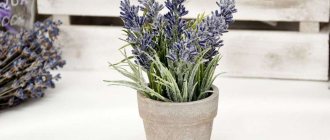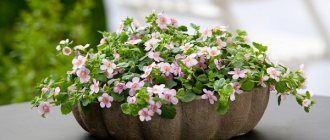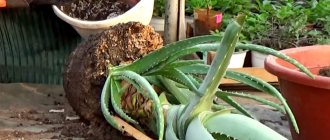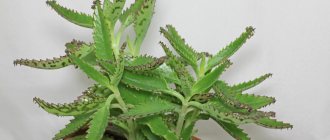In collections of plant design, hibiscus occupies not the last place. This majestic flower has long been loved by gardeners for its highly decorative leaves and variety of colors. The Chinese rose is especially beautiful during its flowering period. There are many varieties of indoor plants, the most popular is a plant with large red roses. Flowers are good because they can be propagated at home. Although these houseplants are considered low-maintenance, novice gardeners still need to learn the basic rules on how to root hibiscus.
General information about the flower
You may be interested in: Indian fern for an aquarium: photo and description, features of maintenance
Hibiscus is a grateful plant; with good care, it pleases flower growers with lush greenery and incredibly beautiful flowers. Among its many varieties there are both garden and indoor specimens. The hibiscus family contains the entire available palette of colors with the exception of blue and black. On average, the life cycle of a Chinese rose bush is 18-20 years. Indoor plants should be protected from negative external influences - direct sunlight and drafts. At the same time, the culture should not be deprived of sufficient light.
You may be interested in: Chlorophytum laxum: photo and description, home care
How the Chinese rose blooms
Chinese rose (indoor) is quite popular among gardeners not only because of its easy maintenance, but also because of its beautiful flowers. They delight with their inflorescences for a short time, only two or three days. But new opening buds constantly appear on the bush, one after another. Therefore, it seems that hibiscus blooms for a long time. But this is provided that the bush is complete and healthy. A photo of a Chinese rose taken during the flowering period is a stunning sight.
The color scheme of the plant can be red and white, purple and orange, and one bud can combine two palettes. These days, specialty stores offer low-growing varieties of hibiscus (hybrids of Dutch species).
Reproduction methods
If you are a novice gardener, you most likely want to plant crops that are easy to care for. The Chinese rose is one of the simplest plants, despite the fact that it looks very luxurious. It is very easy to propagate. The easiest way, which will not cause much trouble, is cuttings. Many indoor plant lovers share their experience on how to root hibiscus at home. To propagate it yourself, you can use the following methods:
- dividing the bush;
- cuttings;
- propagation by seeds;
- by layering (rooting shoots).
Hibiscus propagation is for the patient!
In ancient times, hibiscus was called stockrose, now it is called Chinese rose . Easterners believe that the plant protects the family hearth, helps business people, relieves depression, and radiates positive energy. With careful care, the plant is not afraid of any diseases and it pleases with an abundance of greenery and wonderful flowers.
Selection of propagation material
You may be interested in: Violet pests: photos with descriptions of how to fight
Not everyone knows how to root hibiscus from cuttings correctly, but the further development of the plant depends on the choice and preparation of planting material. A few valuable tips will help you do this correctly. You need to select shoots for propagation immediately after the Chinese rose blooms. If manipulations are carried out during the most beautiful period for the plant, this will make it weak. It will direct all its forces to healing the cut sites, and at this time the hibiscus needs nutrients to form buds. It is necessary to cut branches only from the middle part of the bush. You should carefully examine the plant and select shoots that have already become covered with woody skin. From them, using a knife, segments about 14-15 cm long are cut off. In order not to expose the bush to unnecessary trauma, an oblique cut is made. The cut-off part must have at least three internodes.
How to grow at home?
You need to be careful when choosing a location: hibiscus needs good lighting and protection from the sun . Drafts are unacceptable - the plant cannot tolerate them.
The optimal temperature is 12 -16 degrees, not lower than 10 degrees in winter. Hibiscus requires abundant watering in summer, moderate in autumn, and limited in winter. In summer, it is recommended to spray and fertilize from March until September inclusive.
Important conditions for the procedure
There are two options for how to root hibiscus from cuttings: in water and in soil mixture. When using the first method, it is imperative to regularly moisten the soil. If you ignore this condition, then in an insufficiently moist substrate, the shoots will not produce root shoots. Regardless of which method you choose, it is recommended to create a greenhouse effect for future seedlings. You can cover the container with the cuttings with glass or make a cap for this purpose from plastic film. To avoid their rotting, you need to ventilate the so-called greenhouse. An optimal level of humidity in the substrate will help maintain sphagnum moss. With the appearance of the first few root shoots, the young plant needs to be placed in more nutritious soil, where it will continue to develop. In this case, the top two or three leaves need to be trimmed a little, and several lower ones should be removed.
You may be interested in: Violet pests: photos with descriptions of how to fight
Selection and preparation of cuttings
Depending on the variety, hibiscus can vary in color and size. But all of them lend themselves well to propagation by cuttings, subject to certain rules. First of all, it is important not only to plant and root it correctly, but also to choose it.
Thus, branches with at least several internodes are suitable for propagation. However, it is also not recommended to take a branch that is too large.
You need to cut the cutting with a sharp, pre-cleaned knife, and then sprinkle the cut area with crushed charcoal to disinfect it. Then it can either be sent to damp sand for germination, or placed in water.
In the substrate
How to root a hibiscus sprig in the ground? It is necessary to prepare a container with loose nutrient soil. Then the substrate should be well moistened and a plant branch should be immersed 2 cm into it. A bag should be placed on top of the container with the seedling, thus maintaining the temperature and water balance. Caring for it involves timely removal of condensation. You need to periodically remove the bag and shake out drops of water from it. With this method, the seedling will be ready for transplanting to a permanent location in a month.
The nuances of planting in the ground
In order to properly plant indoor hibiscus in the soil, it is necessary to approach the preparation of the soil and the choice of a permanent pot with all responsibility.
Soil preparation
A young plant with still weak roots should be planted in specially prepared or store-bought soil. To prepare your own soil you will need:
- leaf soil - 1 part;
- peat and sand in equal proportions – 1 hour;
- turf soil - 3 parts;
- mineral fertilizers - 1 g per 1000 g of soil mixture.
Wood ash and crushed activated carbon tablets can be used instead of ready-made fertilizers. Expanded clay, pebbles, and small stones are used as a drainage covering for the bottom of a permanent pot.
Choosing a flowerpot and planting a young plant
The correct approach to choosing a pot for a permanent place for indoor hibiscus ensures the comfortable existence of the young plant and its healthy development:
- The best option is a pot made of clay, ceramics or plastic with ventilation holes in its bottom. Thanks to them, air enters the root system, and excess water flows out, which can cause rotting of the roots.
- It is preferable to choose a pot for young hibiscus that is wide enough, but not very high.
- In very tall dishes, the emphasis of development will be on the stems and crown, while the main trunk and root system will be poorly developed. This can also cause uneven distribution of plant branches.
- Having chosen the right flowerpot, pour drainage onto its bottom and add the prepared soil mixture on top.
- Then, having made a depression sufficient to accommodate the root system, place the young hibiscus in it. In order not to damage the young roots, it is better to use the method of transshipment of a rooted plant. Lightly compact the soil around the stem, water it and add some soil.
Correctly selected volume of dishes, the presence of drainage holes and high-quality soil are a guarantee of success in the formation of healthy hibiscus and its early flowering.
Proper execution of the procedure
Another way to root indoor hibiscus is as follows:
- it is necessary to soak the peat tablet in water;
- Carefully cut off a piece of the required length and dry it a little;
- Place a drainage layer on the bottom of the pot;
- mix the soaked peat tablet with vermiculite;
- pour the resulting substrate on top of the drainage;
- the cut site on the dried part of the shoot must be treated with the preparation “Kornevin”;
- then we immerse the segment into the substrate two centimeters;
- we create greenhouse conditions;
- Next, we monitor the soil moisture.
The seedling should be ventilated every 10-14 days. Root shoots should appear after two months. After this, you need to wait another two weeks until they get stronger, and then transplant the young plant into a beautiful flowerpot. When it takes root in a new place, you need to care for it in the same way as an adult flower.
Saplings
Garden hibiscus is propagated by bending the lower shoot to the ground in the spring, covering it with earth and pinning it. The soil should be moistened for a month until roots appear. Rooted seedlings can be transplanted in the fall or next year in the spring.
When choosing a propagation method, you should remember that cuttings are considered optimal. Plants obtained from seeds will not bloom soon.
See more photos of hibiscus below:
How to root hibiscus from cuttings in water?
This is the easiest way. Despite the fact that adult plants themselves do not tolerate high soil moisture, parts of the shoots feel great in water and produce shoots well. The process consists of several sequential steps:
- it is necessary to cut and prepare parts of the shoots as described above;
- prepare containers; it is better to choose opaque, dark-colored glass;
- to speed up the process of root formation, you can add a growth stimulator or activated carbon to the water;
- You need to immerse the twigs in the liquid halfway, adding it periodically (the water will gradually evaporate).
Seedlings obtained using this method are slightly weaker than those rooted in the ground, but quickly grow stronger and take root well.
Reproduction of elite plants
There are many varieties of hibiscus. Among them there are plants with double flowers. Also with unusually beautiful colors and shapes, which differ significantly from ordinary culture. In view of such diversity, many gardeners have a question about how to root varietal hibiscus. You'll have to be patient here. The fact is that elite specimens produce root shoots much longer than classic ones. Sometimes this process drags on for six months.
It is best to root varietal hibiscus in water. Three basic conditions are required: heat, light and sufficient air humidity. Ziploc bags can be used as a material to create a greenhouse effect. With such a device you will not have to constantly disturb the seedling. It will be enough to simply open the bag once a week and release excess moisture from it. A light coating (callus) will first appear on the part of the cutting that is in water; after a while, roots will gradually begin to grow.
Substrate preparation
You may be interested in: Croton flower: home care, watering, replanting and propagation
We figured out how to root indoor hibiscus cuttings. Next, let's move on to preparing the soil in which the flower will grow constantly. It would be good to purchase a special composition for citrus crops and add a little sand and vermiculite to it. You can prepare the substrate yourself. For this purpose, you need to take: three parts each of leaf and turf soil, one each of humus, charcoal and sand. If these proportions are observed, hibiscus usually develop well, get sick less and live long.
The Chinese rose also feels most comfortable in peat soil. Experienced gardeners advise adding sphagnum moss to it to regulate humidity.
Further care at home and outdoors
In order to maintain the health of hibiscus, it is necessary to follow a number of rules for caring for seedlings and adult plants.
Watering
Hibiscus is a tropical plant, so drought is fatal to it. You need to regularly ensure that the soil in the pot does not dry out.
However, an excess of moisture should also not be allowed, otherwise the plant will rot. So in the summer you can water the hibiscus often, but in the winter only when the soil dries out .
Top dressing
Young bushes that are just entering the active growth phase need a lot of energy and resources. Therefore, they can be fed with nitroammophoska (6 g per liter of water) or “Vermicompost”. A specialized mixture for hibiscus is also suitable.
Transfer
The Chinese rose needs to be replanted every spring in the first three years of the growing season.
At this time, the plant has time to grow to the size of a low bush or small tree. The shape of the crown will depend on the specifics of pruning . After this, the hibiscus needs to be replanted with a break of 2-3 years. Indoor varieties grown in tubs are not replanted, but only replace the top layer of soil.
Trimming
- The best time for pruning is spring or autumn. In the fall, you can prune the bush immediately after flowering, and in the spring before the flower buds open.
- During the period from April to September, pruning is unacceptable.
- At the beginning of winter (in December), it is also undesirable to prune the bush, since this will stimulate the formation of young shoots, and this will weaken the flower.
Shelter for the winter
- Frost-resistant perennial shrubs belong to the garden hibiscus species, so in the southern regions they do not need any special preparation for winter.
- But in the northern regions it is advisable to shelter them.
- Herbaceous hibiscus hybrids are frost-resistant; in winter, the above-ground part of the plant dies off, leaving only a powerful rhizome in the ground. So in order for the bush to survive the winter well, you need to mulch the soil around it.
Hibiscus can be propagated in different ways . The main thing with each of them is to follow the rules of reproduction and provide appropriate care for young plantings. If you follow all the recommendations, you will get a full-fledged flowering bush in a relatively short time.
Features of cultivation
Failure to comply with certain nuances can lead to the plant looking lethargic and ultimately dying. In the end, all your efforts will be in vain. It is important not only to successfully carry out the rooting process, but to continue to take care of this wonderful flower. In order to constantly admire the blooming of the Chinese rose, you need to create an optimal atmosphere for it. She does not like too dry air, so it is better not to place the flowerpot with the plant near the radiator. To avoid flower wilting, spraying procedures must be carried out.
You should not choose a pot that is too wide for replanting the plant. They seem to feel the size of the container and stop developing intensively - the smaller the flowerpot, the more buds there will be on the bush. It is important to understand here that the roots of the plant should not be left with too much space. They also do poorly in plastic containers. Chinese roses bloom for a long time.
The plant needs to be fertilized starting in March. This should be done once a week. To maximize the absorption of nutrients, you need to alternate the application of fertilizers - first feed the crop with a mineral complex, and in the next application add organic matter.
It is important to regularly wipe dust on the leaves or carry out hygiene procedures by spraying. It is also necessary to protect the bush from direct sunlight. You especially need to pay due attention to culture if you have centralized heating, where the air is usually too dry. All care activities should be carried out in moderation.
Feeding for Chinese roses
Chinese rose (indoor) is very responsive to fertilizers. The plant is fed only in the warm season: spring or summer. In cold weather, hibiscus easily survives without additional nutrients. Fertilizers are applied once every two weeks.
There are a lot of complex “foods” for feeding indoor flowers. It is better to purchase them in flower shops.
Fertilizers should include the following elements:
- potassium;
- phosphorus;
- nitrogen.
For the Chinese rose to fully grow, it is necessary to feed its horse system once a month. It is better to dilute all fertilizers in warm, settled water. It is also worth spraying the greenery of the plant with substances containing nitrogen. Do not allow the solution to come into contact with hibiscus flowers, as this may cause stains to appear on them.
You should not “overfeed” or “underfeed” the flower with fertilizers, as the plant can die. It is because of this that the leaves of the Chinese rose turn yellow. Gradually all the greenery will fall off.
Recommendations
According to experienced flower growers, it is best to propagate hibiscus in May. It is at this time of year that the plant experiences its most active growth. It was noticed that after spring rooting, the bushes continue to develop better and their survival rate increases. Although the plant can be propagated all year round.
It is recommended to use various growth stimulants: both special ones and those prepared independently. Without such means, the root system of seedlings develops slowly, especially in elite specimens. They can only form callus and then stop growing.
Flower growers do not recommend propagating Chinese roses from seeds. This is the most unproductive method. Does not leave much chance for success. Firstly, the seeds must be pollinated, which is extremely rare. Secondly, such plants hardly take root or are too weak.
The cut must always be treated with a preparation that promotes root formation. Young green branches should not be used for propagation. Sometimes they produce weak plants, but there is a chance that they will begin to rot. The use of mini-greenhouses during the rooting process is also a mandatory technique.
Peculiarities of reproduction at different times of the year
Considering that the favorable time of year for propagating hibiscus by seeds and dividing the bush is spring, it is advisable to practice these methods in the spring.
But as for cuttings, the plant can be propagated in this amazing way at all times of the year. Rooting of cuttings proceeds well even during periods when the plant is in the dormant phase. True, for this it is necessary to create favorable conditions. However:
- When breeding in spring and summer. Optimal period: from early April to late August. This is a time of active development and growth. And even at this favorable time, May is considered the best period for cuttings. This month marks the maximum mobilization of all plant resources and the most intense metabolic processes. As a result of the combination of these processes, the rooting of cuttings and their survival in a permanent pot gives the highest results.
- In the autumn, all biological processes in plants begin to slow down, so this time is not the most favorable for propagation, even by cuttings.
- It is possible to propagate hibiscus in winter, but you need to be prepared that rooting will take a long time. This is explained by the insufficient duration and amount of lighting, since daylight hours are very short. You can compensate for the deficiency using phyto- or fluorescent lamps. Also, to root cuttings in winter, you will have to create a temperature that is comfortable for the plant. In a cool room, the cutting can rot and become sick.
The best examples of hibiscus can be grown from cuttings that are rooted in spring and summer. But when favorable conditions are created, it is possible to obtain a healthy plant in the autumn-winter period.
How to create a living bouquet of hibiscus
By grafting individual sections from different varieties of Chinese rose, you can get an incredibly beautiful composition that will become the real pride of your plant design. For this purpose, a young plant is used, which is taken as a basis. No more than 4-5 cuttings of other varieties of indoor crops are grafted onto it in the crown area. Such manipulations can only be performed in the summer months. Of course, art culture will need increased feeding and careful care.
Source











